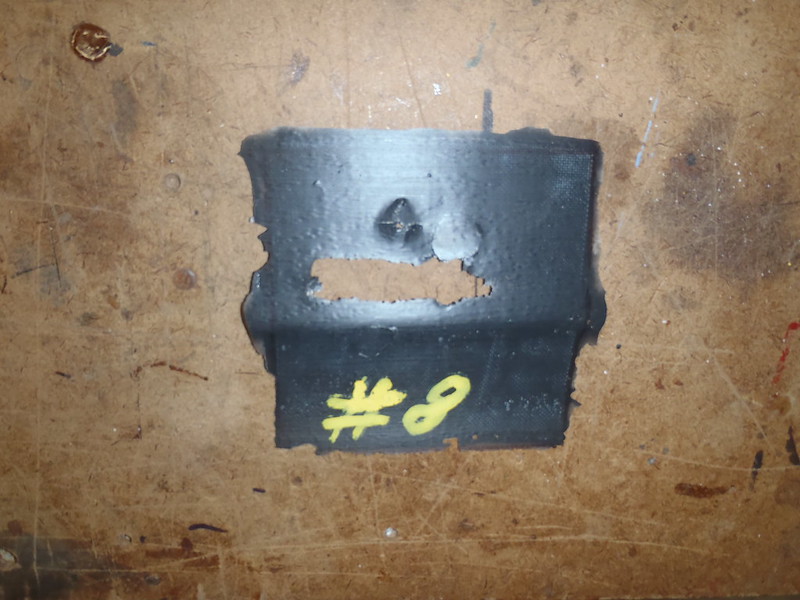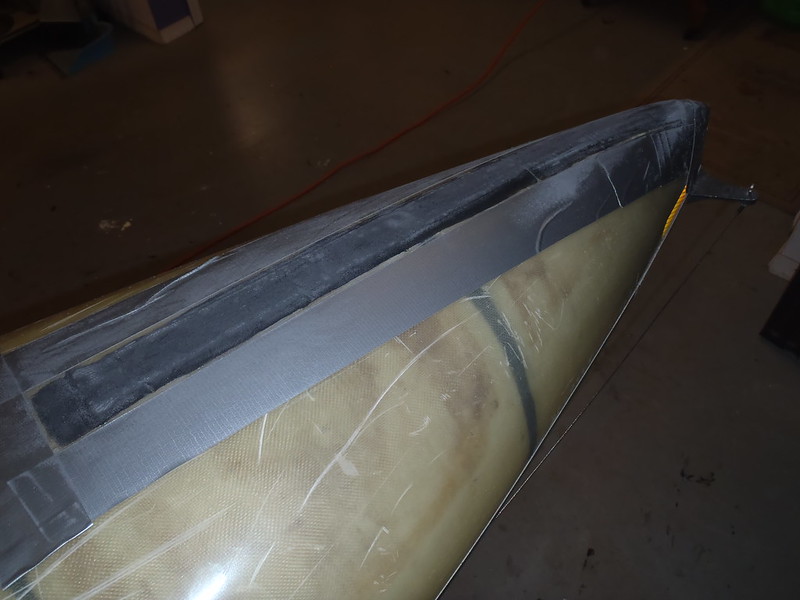G
Guest
Guest
Sanding the old kevlar felt and Twaron tape on the most recent skid plates made something (again) apparent. When I oopsie sanded far enough down there was some yellow felt or white Twaron visible inside/underneath, where the graphite powder and black pigment epoxy did not fully saturate the fabric.
With thick fabrics like kevlar felt or 10oz Twaron it is almost impossible to completely and thoroughly saturate the material (vacuum bagging excepted), and that was with my heavy handed undercoat to lay the material on, and an equally heavy (drippy) top coat allowed to seep in before repeated hard roller compression on the release treated peel ply.
I already knew that from peeling off test fabrics in the skid plate materials experiment.
http://www.canoetripping.net/forums/...stance-results
When I peeled off the test fabrics off in that experiment the thicker stuff, including the kevlar felt, kevlar tape, and thickly woven carbon fiber all showed that they were resin starved in places underneath.
Kevlar felt underside
 P3200012 by Mike McCrea, on Flickr
P3200012 by Mike McCrea, on Flickr
Kevlar tape underside
 P3290030 by Mike McCrea, on Flickr
P3290030 by Mike McCrea, on Flickr
Those were done using less viscous 100% West 105/206, a wasteful thick base and equally wasteful, drippy top coat. I suspect that kevlar as a felt or woven tape is hard (impossible?) to completely saturate by hand.
On a positive note the 5oz Dynel in that experiment did saturate thoroughly and completely on those peeled off bottom inspections.
 P3290034 by Mike McCrea, on Flickr
P3290034 by Mike McCrea, on Flickr
Sanding the paint topcoat off the kevlar felt on the old skid plates, which had red pigment added to the epoxy, revealed considerable yellow (pink?) in the kevlar where I oopsie sanded all the way into the felt before installing the Dynel layer.
Same with sanding into the 14ml thick Twaron tape for a 2[SUP]nd[/SUP] epoxy coat, I got into some hints of still-white Twaron where the graphite and black pigmented epoxy didn’t full saturate.
 PB110025 by Mike McCrea, on Flickr
PB110025 by Mike McCrea, on Flickr
That is a (typically) long way of saying I am unable to thoroughly epoxy-saturate thick fabrics, and I have a heavy hand with epoxy coats. Vacuum bagging is not in my future, but at least I know that a single layer of Dynel saturates thoroughly under peel ply compression.
With thick fabrics like kevlar felt or 10oz Twaron it is almost impossible to completely and thoroughly saturate the material (vacuum bagging excepted), and that was with my heavy handed undercoat to lay the material on, and an equally heavy (drippy) top coat allowed to seep in before repeated hard roller compression on the release treated peel ply.
I already knew that from peeling off test fabrics in the skid plate materials experiment.
http://www.canoetripping.net/forums/...stance-results
When I peeled off the test fabrics off in that experiment the thicker stuff, including the kevlar felt, kevlar tape, and thickly woven carbon fiber all showed that they were resin starved in places underneath.
Kevlar felt underside

Kevlar tape underside

Those were done using less viscous 100% West 105/206, a wasteful thick base and equally wasteful, drippy top coat. I suspect that kevlar as a felt or woven tape is hard (impossible?) to completely saturate by hand.
On a positive note the 5oz Dynel in that experiment did saturate thoroughly and completely on those peeled off bottom inspections.

Sanding the paint topcoat off the kevlar felt on the old skid plates, which had red pigment added to the epoxy, revealed considerable yellow (pink?) in the kevlar where I oopsie sanded all the way into the felt before installing the Dynel layer.
Same with sanding into the 14ml thick Twaron tape for a 2[SUP]nd[/SUP] epoxy coat, I got into some hints of still-white Twaron where the graphite and black pigmented epoxy didn’t full saturate.

That is a (typically) long way of saying I am unable to thoroughly epoxy-saturate thick fabrics, and I have a heavy hand with epoxy coats. Vacuum bagging is not in my future, but at least I know that a single layer of Dynel saturates thoroughly under peel ply compression.
